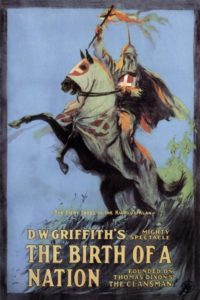HNC Photography, IFC - Coursework, Introduction to Film Culture Blog, Movies watched, Part three - Fact or fiction? Truth or lies?, Project 2 - The birth of propaganda, Research & Reflection IFC
 The Birth of a Nation (1915)
The Birth of a Nation (1915)
Dir: D.W. Griffiths
Synopsis
The Stoneman family finds its friendship with the Camerons affected by the Civil War, both fighting in opposing armies. The development of the war in their lives plays through to Lincoln’s assassination and the birth of the Ku Klux Klan.
Review
“Birth of a Nation” is a difficult film to view as it is terribly racist; however, this racism has to acknowledged and looked past to understand its historical significance. As quoted in Time Magazine “100 years later Still Great, Still Shameful.”
Overall the film is a story how the American Civil War affected the lives of everyone in the USA. How it separated friends and families often pitting them against each other. The film is a sprawling epic over 3 hours in length, and Director Griffith used all his collected skill to create a film with narrative structure, drama and tension.
:
This movie employs all the techniques Griffith had been perfecting over his years at Biograph:
• the use of ornate title cards
• the particular use of subtitles graphically verbalising imagery
• its original musical score, written for an orchestra
• the introduction of night photography (using magnesium flares)
• the use of outdoor natural landscapes as backgrounds
• the definitive usage of the still-shot
• elaborate costuming to achieve historical authenticity and accuracy
• many scenes innovatively filmed from many different and multiple angles
• the technique of the camera “iris” effect (expanding or contracting circular masks to either reveal and open up a scene or close down and conceal a part of an image)
• the use of parallel action and editing in a sequence (Gus’ attempted rape of Flora, and the KKK rescues of Elsie from Lynch and of Ben’s sister Margaret)
• extensive use of colour tinting for dramatic or psychological effect in sequences
• moving, travelling or “panning” camera tracking shots
• the efficient use of total screen close-ups to reveal intimate expressions
• beautifully crafted, intimate family exchanges
• the use of vignettes seen in “balloons” or “iris-shots” in one portion of a darkened screen
• the use of fade-outs and cameo-profiles (a medium closeup in front of a blurry background)
• the use of lap dissolves to blend or switch from one image to another
• high-angle shots and the abundant use of panoramic long shots
• the dramatisation of history in a moving story – an example of an early spectacle or epic film with historical costuming and many historical references (e.g., Mathew Brady’s Civil War photographs)
• impressive, splendidly-staged battle scenes with hundreds of extras (made to appear as thousands)
• extensive cross-cutting between two scenes to create a montage effect and generate excitement and suspense (e.g., the scene of the gathering of the Klan)
• expert story-telling, with the cumulative building of the film to a dramatic climax
And whether it is or is historically accurate – it looks it. Even today the footage look almost documentary in style, and it would have been astounding to the audiences of the day. Yes, the use of actors in “Black face” is outrageous however that is something we can see today. In 1915 even the most liberal of the viewers would have perhaps not even noticed as they marvelled at the movie picture.
The technical ability of Griffiths editing does give the film a modern feel at there is tension with the scenes parallel action is intercut together. In fact when this is the Klu Klux Klan riding to the rescue it does give us, a modern viewer, an uncomfortable feeling as we could be routeing for the wrong side.
Can the film be seen as propaganda for keeping the USA out of WW1? Perhaps it does show the destruction to people lives that war can bring. The film is shot from the point of view of the South (the Confederacy) and does portray Lincoln as using presidential power to subdue a sovereign nation’s (the Confederacy) wishes.
The film could have thrown seeds of doubts into the minds of the public as it does indeed not show the glory and patriotism of war that we saw in Love and Glory’ from the Spanish – American War.
Overall what “The Birth of the Nation” is a shame, grossly inaccurate but technically brilliant misrepresentation of US History. However, it should not be forgotten because cinema owes a great deal to it and its creator.
